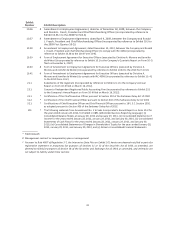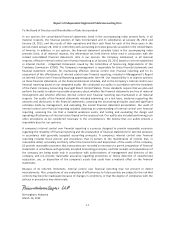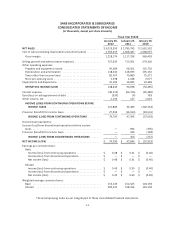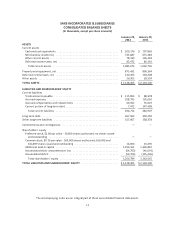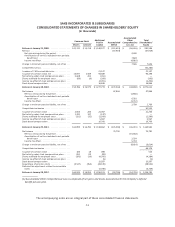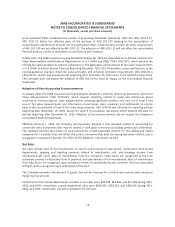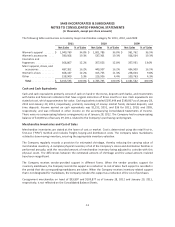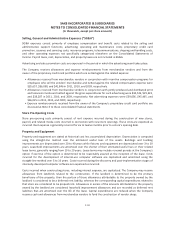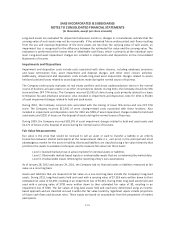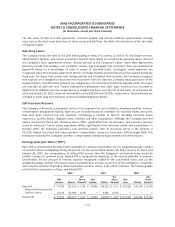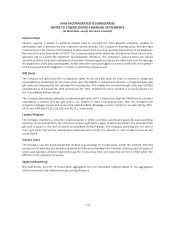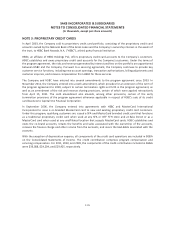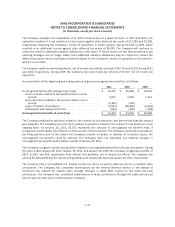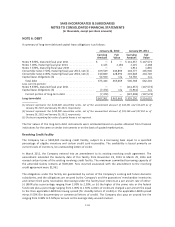Saks Fifth Avenue 2011 Annual Report Download - page 55
Download and view the complete annual report
Please find page 55 of the 2011 Saks Fifth Avenue annual report below. You can navigate through the pages in the report by either clicking on the pages listed below, or by using the keyword search tool below to find specific information within the annual report.SAKS INCORPORATED & SUBSIDIARIES
NOTES TO CONSOLIDATED FINANCIAL STATEMENTS
(In thousands, except per share amounts)
Selling, General and Administrative Expenses (“SG&A”)
SG&A expenses consist primarily of employee compensation and benefit costs related to the selling and
administrative support functions; advertising; operating and maintenance costs; proprietary credit card
promotion, issuance and servicing costs; insurance programs; telecommunications; shipping and handling costs;
and other operating expenses not specifically categorized elsewhere on the Consolidated Statements of
Income. Payroll taxes, rent, depreciation, and property taxes are not included in SG&A.
Advertising and sales promotion costs are expensed in the period in which the advertising event takes place.
The Company receives allowances and expense reimbursements from merchandise vendors and from the
owner of the proprietary credit card portfolio which are netted against the related expense:
• Allowances received from merchandise vendors in conjunction with incentive compensation programs for
employees who sell the vendors’ merchandise and netted against the related compensation expense were
$35,657, $36,098, and $41,846 in 2011, 2010, and 2009, respectively.
• Allowances received from merchandise vendors in conjunction with jointly produced and distributed print
and television media and netted against the gross expenditures for such advertising were $30,526, $29,323,
and $33,287 in 2011, 2010, and 2009, respectively. Net advertising expenses were $59,036, $45,465, and
$36,025 in 2011, 2010, and 2009, respectively.
• Expense reimbursements received from the owner of the Company’s proprietary credit card portfolio are
discussed at Note 3 to these consolidated financial statements.
Store Pre-Opening Costs
Store pre-opening costs primarily consist of rent expense incurred during the construction of new stores,
payroll, and related media costs incurred in connection with new store openings. These costs are expensed as
incurred. Rent expense is generally incurred for six to twelve months prior to a store’s opening date.
Property and Equipment
Property and equipment are stated at historical cost less accumulated depreciation. Depreciation is computed
using the straight-line method over the estimated useful lives of the assets. Buildings and building
improvements are depreciated over 20 to 40 years while fixtures and equipment are depreciated over 3 to 10
years. Leasehold improvements are amortized over the shorter of their estimated useful lives or their related
lease terms, generally ranging from 10 to 20 years. Lease terms may include renewal periods at the Company’s
option if exercise of the option is determined to be reasonably assured at the inception of the lease. Costs
incurred for the development of internal-use computer software are capitalized and amortized using the
straight-line method over 3 to 10 years. Costs incurred during the discovery and post-implementation stages of
internally-developed computer software are expensed as incurred.
Costs incurred when constructing stores, including interest expense, are capitalized. The Company may receive
allowances from landlords related to the construction. If the landlord is determined to be the primary
beneficiary of the property, then the portion of those allowances attributable to the property owned by the
landlord is considered to be a deferred rent liability, whereas the corresponding capital expenditures related to
that store are considered to be prepaid rent. Allowances in excess of the amounts attributable to the property
owned by the landlord are considered leasehold improvement allowances and are recorded as deferred rent
liabilities that are amortized over the life of the lease. Capital expenditures are reduced when the Company
receives cash and allowances from merchandise vendors to fund the construction of vendor shops.
F-10


